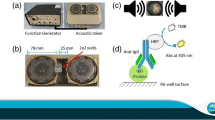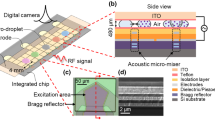Abstract
In the context of the COVID-19 epidemic, enhancing the transport of analyte to a sensor surface is crucial for rapid detection of biomolecules, since common conditions including low diffusion coefficients cause inordinately long detection times. SAW-based method owns low propagation loss, low power consumption, and ease of integration. However, the microstreaming effect is not stable and predictable using the bubble-induced acoustofluidic mixers. There is a strong need for developing efficient and robust acoustic devices for enhancing immunoassays. We herein take advantage of dual SAW streaming flow to enhance a continuous and non-invasive mixing of the target molecule with the immobilized antibody region. Acoustic streaming flow is utilized to stir the flow field in the micro-chamber, accelerate the transport of analyte to the functionalized surface and simultaneously minimize the localized target depletion. Using simulations, an optimized design of the proposed microfluidic chip is proposed based on the immunoassay enhancement by investigating the influences of the position of the reaction surface, the chamber height, the excitation frequency, the applied voltage, the antibody concentration, and the reaction rate on the binding performance. To the best of authors’ knowledge, it is the first investigation of enhancing immunoassays in SAW-based devices by optimizing the key parameters using simulations. As a result, the sensor target interaction can be enhanced and the nonspecific molecules can be simultaneously displaced from the reaction surface. The current Acoustic streaming flow assisted immunoassay technology can also be extended to other proteins, DNA and cell analysis.









Similar content being viewed by others
Data availability
The data that support the findings of this study are available from the corresponding author upon reasonable request.
References
Alghane M, Fu YQ, Chen BX, Li Y, Desmulliez MPY, Walton AJ (2012) Frequency effect on streaming phenomenon induced by Rayleigh surface acoustic wave in microdroplets. J Appl Phys 112(8):084902
Chaibun T, Puenpa J, Ngamdee T, Boonapatcharoen N, Athamanolap P, O’Mullane AP, Vongpunsawad S, Poovorawan Y, Lee SY, Lertanantawong B (2021) Rapid electrochemical detection of coronavirus SARS-CoV-2. Nat Commun 12(1):802
Choi JR (2020) Development of point-of-care biosensors for COVID-19. Front Chem 8:517
Dentry MB, Yeo LY, Friend JR (2014) Frequency effects on the scale and behavior of acoustic streaming. Phys Rev E Stat Nonlin Soft Matter Phys 89(1):013203
Gervais L, de Rooij N, Delamarche E (2011) Microfluidic chips for point-of-care immunodiagnostics. Adv Mater 23(24):H151-176
Guo F, Mao Z, Chen Y, Xie Z, Lata JP, Li P, Ren L, Liu J, Yang J, Dao M, Suresh S, Huang TJ (2016) Three-dimensional manipulation of single cells using surface acoustic waves. Proc Natl Acad Sci U S A 113(6):1522–1527
Huang PH, Xie Y, Ahmed D, Rufo J, Nama N, Chen Y, Chan CY, Huang TJ (2013) An acoustofluidic micromixer based on oscillating sidewall sharp-edges. Lab Chip 13(19):3847–3852
Kaziz S, Saad Y, Bouzid M, Selmi M, Belmabrouk H (2021) Enhancement of COVID-19 detection time by means of electrothermal force. Microfluid Nanofluidics 25(10):86
Leahy S, Lai Y (2016) An hourglass design with electrokinetic sampling and electrothermal actuation for micro biosensors. Sens Actuators, B Chem 223:123–130
Lewpiriyawong N, Kandaswamy K, Yang C, Ivanov V, Stocker R (2011) Microfluidic characterization and continuous separation of cells and particles using conducting poly(dimethyl siloxane) electrode induced alternating current-dielectrophoresis. Anal Chem 83(24):9579–9585
Lynn NS Jr, Martinez-Lopez JI, Bockova M, Adam P, Coello V, Siller HR, Homola J (2014) Biosensing enhancement using passive mixing structures for microarray-based sensors. Biosens Bioelectron 54:506–514
Mao Z, Xie Y, Guo F, Ren L, Huang PH, Chen Y, Rufo J, Costanzo F, Huang TJ (2016) Experimental and numerical studies on standing surface acoustic wave microfluidics. Lab Chip 16(3):515–524
Morales-Narvaez E, Guix M, Medina-Sanchez M, Mayorga-Martinez CC, Merkoci A (2014) Micromotor enhanced microarray technology for protein detection. Small 10(13):2542–2548
Morozov VN, Groves S, Turell MJ, Bailey C (2007) Three minutes-long electrophoretically assisted zeptomolar microfluidic immunoassay with magnetic-beads detection. J Am Chem Soc 129(42):12628–12629
Nam J, Lim CS (2016) A conductive liquid-based surface acoustic wave device. Lab Chip 16(19):3750–3755
Nam J, Jang WS, Lim CS (2018) Micromixing using a conductive liquid-based focused surface acoustic wave (CL-FSAW). Sens Actuators, B Chem 258:991–997
Ni Z, Yin C, Xu G, Xie L, Huang J, Liu S, Tu J, Guo X, Zhang D (2019) Modelling of SAW-PDMS acoustofluidics: physical fields and particle motions influenced by different descriptions of the PDMS domain. Lab Chip 19(16):2728–2740
Qi C, Duan JZ, Wang ZH, Chen YY, Zhang PH, Zhan L, Yan XY, Cao WC, Jin G (2006) Investigation of interaction between two neutralizing monoclonal antibodies and SARS virus using biosensor based on imaging ellipsometry. Biomed Microdevices 8(3):247–253
Renaudin A, Chabot V, Grondin E, Aimez V, Charette PG (2010) Integrated active mixing and biosensing using surface acoustic waves (SAW) and surface plasmon resonance (SPR) on a common substrate. Lab Chip 10(1):111–115
Trick AY, Chen FE, Chen L, Lee PW, Hasnain AC, Mostafa HH, Carroll KC, Wang TH (2022) Point-of-care platform for rapid multiplexed detection of SARS-CoV-2 variants and respiratory pathogens. Adv Mater Technol 7(6):2101013
Wang B, Cheng X (2016) Enhancement of binding kinetics on affinity substrates by laser point heating induced transport. Analyst 141(5):1807–1813
Welch NL, Zhu M, Hua C, Weller J, Mirhashemi ME, Nguyen TG, Mantena S, Bauer MR, Shaw BM, Ackerman CM, Thakku SG, Tse MW, Kehe J, Uwera MM, Eversley JS, Bielwaski DA, McGrath G, Braidt J, Johnson J, Cerrato F, Moreno GK, Krasilnikova LA, Petros BA, Gionet GL, King E, Huard RC, Jalbert SK, Cleary ML, Fitzgerald NA, Gabriel SB, Gallagher GR, Smole SC, Madoff LC, Brown CM, Keller MW, Wilson MM, Kirby MK, Barnes JR, Park DJ, Siddle KJ, Happi CT, Hung DT, Springer M, MacInnis BL, Lemieux JE, Rosenberg E, Branda JA, Blainey PC, Sabeti PC, Myhrvold C (2022) Multiplexed CRISPR-based microfluidic platform for clinical testing of respiratory viruses and identification of SARS-CoV-2 variants. Nat Med 28(5):1083–1094
Woo CH, Jang S, Shin G, Jung GY, Lee JW (2020) Sensitive fluorescence detection of SARS-CoV-2 RNA in clinical samples via one-pot isothermal ligation and transcription. Nat Biomed Eng 4(12):1168–1179
Wu Y, Ren Y, Tao Y, Hou L, Jiang H (2018) High-throughput separation, trapping, and manipulation of single cells and particles by combined dielectrophoresis at a bipolar electrode array. Anal Chem 90(19):11461–11469
Wu Y, Hu B, Ma X, Wang Y, Li W, Wang S (2022) Enhancement of binding kinetics on affinity substrates using asymmetric electroosmotic flow on a sinusoidal bipolar electrode. Micromachines (basel) 13(2):207
Xie Y, Ahmed D, Lapsley MI, Lin S-CS, Nawaz AA, Wang L, Huang TJ (2012) Single-shot characterization of enzymatic reaction constants Km and kcat by an acoustic-driven, bubble-based fast micromixer. Anal Chem 84(17):7495–7501
Zeng Q, Guo F, Yao L, Zhu HW, Zheng L, Guo ZX, Liu W, Chen Y, Guo SS, Zhao XZ (2011) Milliseconds mixing in microfluidic channel using focused surface acoustic wave. Sens Actuators, B Chem 160(1):1552–1556
Funding
This work is supported by the National Natural Science Foundation of China (62104195), Key Research and Development Program of Shaanxi (2022SF-111), China Postdoctoral Science Foundation (2022M712597), Basic Research Programs of Taicang, 2022 (TC2022JC06), Gusu innovation and entrepreneurship leading talent (ZXL2022455), Guang Dong Basic and Applied Basic Research Foundation (2023A1515011219), Industrial Development and Foster Project of Yangtze River Delta Research Institute of NPU, Taicang (CY20210204). We would like to thank the Analytical and Testing Center of Northwestern Polytechnical University for fabricating microfluidic chips.
Author information
Authors and Affiliations
Contributions
Conceptualization, YW and YM; methodology, YW; software, YW and YM; formal analysis, YW; investigation, YM; writing—original draft preparation, YW and YM; supervision, YW; project administration, YW; funding acquisition, YW. All authors have read and agreed to the published version of the manuscript.
Corresponding authors
Ethics declarations
Conflict of interest
The authors have no conflicts to disclose.
Additional information
Publisher's Note
Springer Nature remains neutral with regard to jurisdictional claims in published maps and institutional affiliations.
Supplementary Information
Below is the link to the electronic supplementary material.
Rights and permissions
Springer Nature or its licensor (e.g. a society or other partner) holds exclusive rights to this article under a publishing agreement with the author(s) or other rightsholder(s); author self-archiving of the accepted manuscript version of this article is solely governed by the terms of such publishing agreement and applicable law.
About this article
Cite this article
Meng, Y., Wu, Y. Numerical characterization and optimization of the acoustic device for heterogeneous immunoassays. Microfluid Nanofluid 27, 71 (2023). https://doi.org/10.1007/s10404-023-02676-x
Received:
Accepted:
Published:
DOI: https://doi.org/10.1007/s10404-023-02676-x




